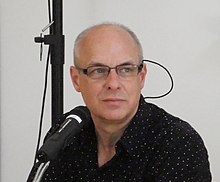Ambient

Ambient is a variant of electronic music in which spherical, gentle, drawn out and warm sounds dominate. In ambient music, rhythm and percussion are in the background or are not present at all; they appear as subtle percussion textures, as arpeggios or in rhythmically introduced melody and bass sequences. Spatial effects, soundscapes and field recordings are often experimented with, and electronic organs (keyboards) and wind instruments are often used. Natural sounds, language and singing also have their place. The pieces of music are usually very slow and long, often build up slowly and merge into one another, although they rarely follow a classic song structure.
Important representatives who produce or have produced in this genre are Harold Budd , Geir Jenssen , Thomas Köner , Bill Laswell , Pete Namlook , Oöphoi , Robert Rich and Steve Roach .
history
The futurist Francesco Balilla Pratella advocated atonality and irregular rhythm in music as early as 1911 in his technical manifesto . Luigi Russolo announced the art of noise as the music of the future in his futuristic manifesto L'arte dei rumori , published in 1913, and like Pratella wrote pieces of music to match. Today Russolo is considered a pioneer of synthetic music. In 1920 Erik Satie composed "Musik als Möbel" ( Musique d'ameublement , furniture music ), which can be seen as an early form of ambient.
Former Roxy Music member Brian Eno , who shaped the style with the release of his album Ambient 1: Music for Airports , is considered to be the founder of Ambient . The release was actually intended as music for public buildings like airports. It aspired to be pleasant and interesting for people passing through as well as for those waiting, even if the waiting time is so long that the album is played several times in a row.
Related styles
The boundaries between ambient and other styles of electronic music are fluid. Closely related to ambient is, for example, muzak , which is commonly used in elevators, department stores, hotels and some work environments and is sometimes referred to as "elevator music".
Space Music is also related to Ambient , the most famous representative of which is the American Jonn Serrie .
Sometimes Dark Ambient , a genre that primarily tries to create dark and gloomy atmospheres, is categorized as a subgenre of Ambient. Despite the name, many dark ambient artists have their roots primarily in the industrial environment. A related genre is Illbient, made famous by DJ Spooky . Some representatives of Black Metal have changed their style to (Dark) Ambient or have combined both styles. Examples are Burzum , Darkspace and Vinterriket .
Live ambient
Live ambient is a variety of ambient similar to live electronics in electroacoustic music and jam sessions in jazz and rock . In contrast to the compositions otherwise arranged by individual artists in the studio, the focus of Live Ambient is on group improvisation. In contrast to bands , both the staffing and the distribution of tasks among the participating musicians are open and variable; there is no fixed core cast in the usual sense. The individual sessions are public.
Furthermore, the live ambient focuses on the musical and social experience during group improvisation, both for the musicians and the audience. The commercial marketability of the musical results, however, plays a subordinate role. Instead of albums , recordings of a session, which may be reworked and divided into (named) pieces, and their often multimedia documentation, are usually made freely accessible.
In 2002 Karsten Koch and Enzo Cage founded the live ambient project Testrauschen in Munich . In 2004, this resulted in the Spheric Lounge project . Thanks to its open structure, this project developed into a forum for the Munich electronic music scene and attracted video artists and improvisation dancers. By the end of 2014, Spheric Lounge had produced well over 500 live ambient music tracks in 100 sessions.
Inspired by Spheric Lounge , further regional live ambient projects have been created since 2006. Including the EK Lounge in the Rhine-Main area and the Ambient Circle in the Ruhr area . Through several live ambient festivals and the networking of the various projects, a German-language live ambient scene was created.
See also
Web links
- 25 years of ambient music (English)
- Ambient Music Links (English)
- ambient music - dictionary of film terms (German)
- Recontextualizing Ambient Music in Csound by Kim Cascone